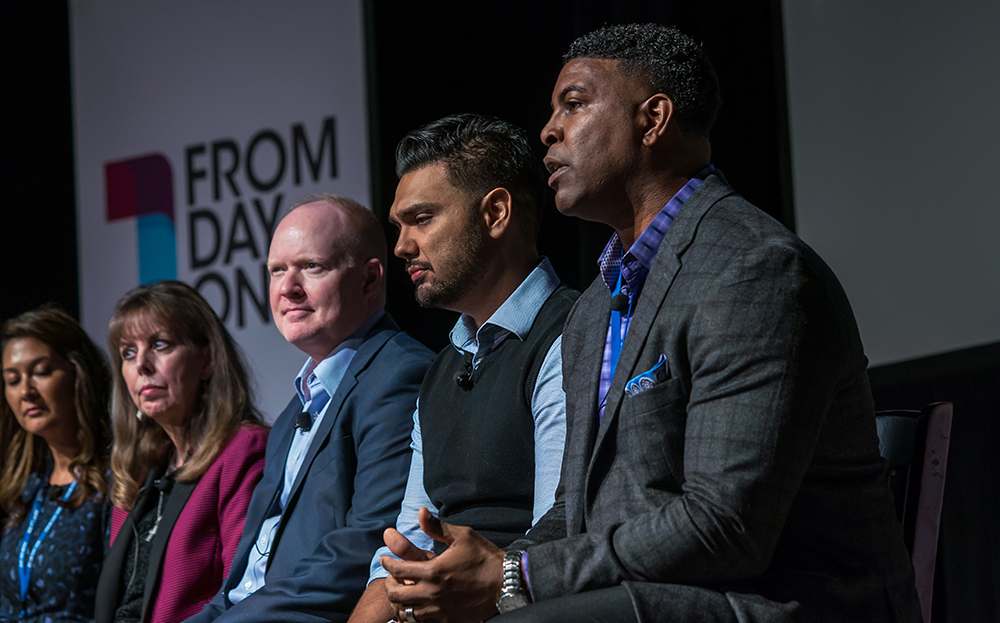A Sense of Belonging and Growth: What Really Matters in Employee Satisfaction


It’s one thing to tell employees, particularly during the hiring process, that they’ll be valued. It’s another to actually deliver on that promise and ensure their continued satisfaction from the first day forward.
Doing so, however, can lead to a win-win for all parties involved. Employee satisfaction increases engagement, motivation, loyalty, staff retention and, overall, productivity and the bottom line, according to panelists discussing the issue at the From Day One conference in Dallas.
“If you think about engagement, there’s multiple different types of engagement,” said Suminder Sran, Boarding Pass venture lead at Pricewaterhouse Coopers (PwC). “There’s technical engagement and people engagement. Specifically around people engagement, one of the biggest findings for us was the criticality [of the] relationship between hiring manger and new hire.”
If a hiring manager “forgets to pick up a new hire” on the first day after making sweeping promises, Sran said, “engagement starts to fall off” and the new employee begins thinking: “Maybe I shouldn’t be here.”
Ensuring satisfaction, then, begins even before onboarding, which should also be seamless and welcoming, and should remain an ongoing effort from there, said the speakers on the panel, moderated by Rob Schneider, managing editor–events for the Dallas Business Journal.
Managers should be thinking at all times about individual employee growth, which is tied directly to the company’s evolution as well. “In today’s economy, upskilling and reskilling are very important,” said Curtis Brooks, vice president of employee performance management at U.S. Bank. While Brooks operates in the financial sector, he pointed out that such advancement should be applied across all industries.
“Employees really want to be heard; they want to be developed,” said Ruth Tilley, vice president and HR business partner at McKesson. “They want to have career opportunities and progression.”
At McKesson, she said, an employee survey is conducted every year to help gauge and increase employee satisfaction. “What I love about it is, this year we had 92% participation, which is not abnormal for McKesson,” she said. “The reason we have 92% participation is that they feel as if we’re listening–and we actively ask them questions. We take their feedback, and we turn it into action, year after year."
Imagining an employee’s motivation, Tilley said: “It’s worth 30 minutes of my time to tell you what you’re good at and what you’re not so good at and what I want.”
Smart hiring, surveys and fitting tasks to the right employees are also key, said Sharla Jones, vice president, learning & development manager at Hilltop Holdings. “How many of you get to do what you do best every day?” she asked conference attendees, providing the “unfortunate” answer that only about 21% of people respond affirmatively to that question. Yet this is easily fixable, she said, and beneficial to employee and employer.

“When employees are focused on their strengths, they look forward to going to work. They have more positive interactions with people,” Jones said. “They’re able to be more creative and innovative. They tell people they work for a great company. They even have the ability to produce, get results.”
“Engagement, I think, is a choice,” Jones said. “We work because we have to; we engage because we choose to. There is an influence that managers have on that engagement, when people can focus on their strengths. That doesn’t happen overnight. It takes understanding, it takes ownership–and the ability to spend some time on that.”
Building on the strengths employees already have can undeniably fuel a company’s success, panelists said, but linking the company’s mission or products to the lives of staff can also forge a bond and increase satisfaction.
As an example, Nolan Godfrey, executive consultant and coach at Stewart Leadership, cited an automotive corporation that lets “their employees drive their automobiles. They give them a very generous program where they can do that,” he said.
“Aligning some of the perks with the culture and with the company, that helps them feel appreciated and connected to the things they’re trying to sell or manufacture,” Godfrey said. “Being industry specific,” that’s one angle that can be really helpful, he said.
It all comes down to involvement, communication, evolution and a shared mission, panelists said. “People want to be developed,” said Brooks.
“Thinking about the employee and their whole selves–if companies will do that and do it well, everyone would want to work for a company that thinks about that whole person,” Tilley said.
Godfrey reiterated that satisfaction would obviously have “ebbs and flows,” but “when you have a focus on an employee’s entire experience … you can really have a lot of leverage around satisfaction.”
Sran added: “At the end of the day, when staff is coming to work for your companies, they want to feel like they’ll belong … They’ll want to feel like they made the right decision.”
Sheila Flynn is a New York-based journalist who has written for DailyMail.com, the Irish Daily Mail, and the Associated Press. She is a graduate of the University of Notre Dame
The From Day One Newsletter is a monthly roundup of articles, features, and editorials on innovative ways for companies to forge stronger relationships with their employees, customers, and communities.